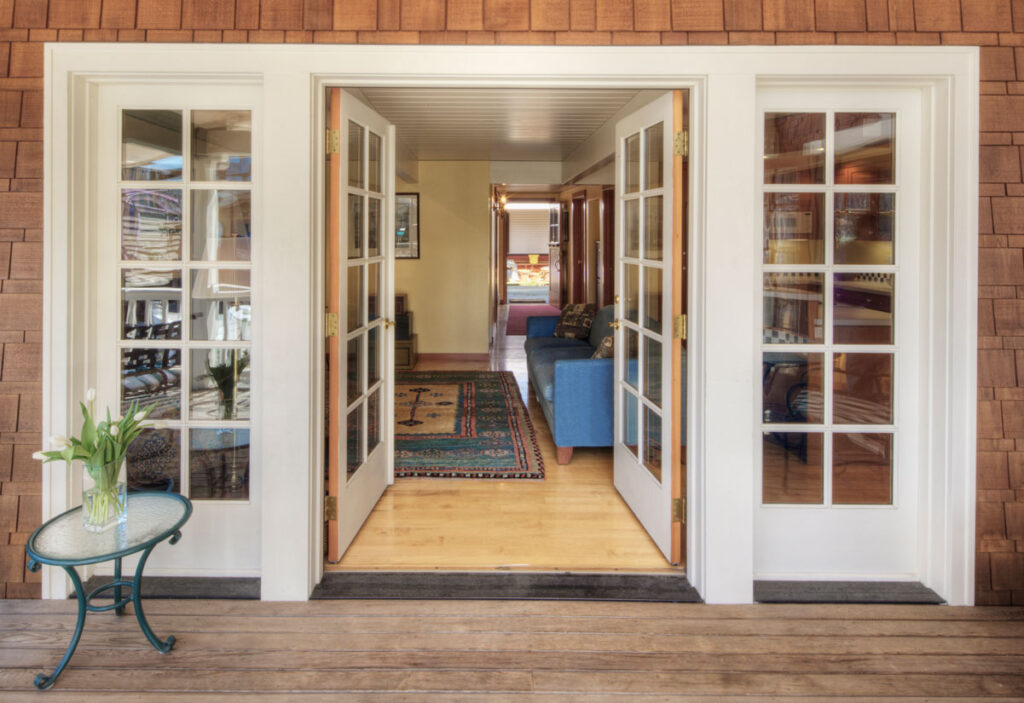For a dash of sophistication and allure, consider the allure of French doors, whether for the interior or exterior of your home. They bring an exquisite touch to your living space without necessitating an extensive overhaul. What’s more, when it comes to exterior French doors, they are superbly insulated, ensuring that your sanctuary remains impervious to inclement weather, regardless of the season.
Not every homeowner craves the conventional sliding door to their patio or garden. French doors present themselves as an eloquent and practical alternative.
Unraveling the Distinctiveness of French Doors
The essential divergence between French doors and their conventional counterparts lies in their design elements. French doors are typically configured in pairs and open from the center, either inward or outward, depending on the homeowner’s predilection. Those fortunate enough to possess an abundance of space frequently opt for French doors as their gateway to patios or gardens. The nuances of French door design encompass:
- Ornate wrought iron details paired with clear glass.
- The option of brass or zinc accents.
- Various styles of hinges, knobs, and door handles.
- An array of colors and finishes to harmonize with your decor.
- The availability of transoms and sidelights.
- Stringent security features for external French doors.
- Lighter-weight alternatives for internal use.
- Tailoring opportunities for a personalized touch.
A Glimpse into the Origins of French Doors

The term “French door” is far from arbitrary; it symbolizes an esteemed architectural legacy cherished by Bloomfield residents for a myriad of compelling reasons. This quintessential style emerged during the 17th century in France, becoming an emblematic facet of the French Renaissance period. The symmetry and grace intrinsic to French doors are emblematic of this historical era, laying the foundation for the beloved French doors we are familiar with today.
Despite their French moniker, these doors were originally oversized windows, aptly referred to as “porte-fenêtre” or window doors by French architects. The evolution of French doors has seen them crafted from a spectrum of materials, including uPVC, composite, aluminum, and timber, broadening their applicability and appeal.
Deciphering French Door Dimensions
French doors extend a range of sizing options, accommodating both standardized factory dimensions and custom-made configurations to harmonize with the distinctive layout of your Bloomfield abode. They manifest as either in-swing or out-swing, opening as pairs of doors that pivot from the center of the doorframe. The conventional French door dimensions span from 1 foot 6 inches to 3 feet in width, while stock door heights commonly fall within the 6 feet 8 inches to 7 or 8 feet range. In case you harbor any doubts about the compatibility of your exterior or interior opening, it’s prudent to consult a seasoned contractor or consultant before embarking on your purchase.
The Advantages of French Doors in Bloomfield
Beyond their aesthetic appeal and curbside charm, French doors deliver an array of benefits:
- With both panels in the open position, they facilitate maximum airflow.
- They usher in abundant natural light and unfettered views of the great outdoors.
- French doors offer diverse enhancements, including a tilt-and-turn mechanism for secure ventilation, a multi-point locking system, and integrated mini-blinds for added privacy.
- The option of low-profile frames with or without visible hinges and a selection of standard or custom colors.
- The availability of factory pre-painted options, maintenance-free vinyl alternatives, and choices between smooth paint-grade or textured stain-grade finishes.
Tailor your selection from an extensive array of French doors, accommodating even unconventional spaces without standard measurements. Let the rejuvenating zephyrs breathe new life into your living spaces with the allure of French doors.
Unraveling the Distinction: Garden Doors Versus French Doors

When homeowners are compelled to embrace their patios, gardens, or the great outdoors, they often stand at the crossroads between garden doors and French doors. To foster clarity, we delineate the core disparities between these two alternatives:
Design
While the two share a semblance in appearance, their designs diverge. Garden doors typically incorporate one solid door and one that opens. French doors, on the other hand, feature two opening doors, providing a more expansive ingress, superior ventilation, and a more capacious passageway.
Accessibility
French doors provide a more generous aperture, rendering the movement of a crowd more seamless and efficient. This attribute proves invaluable when hosting sizable gatherings at your abode.
Sturdiness
Sturdiness is where these options deviate. French doors lack a solid center support since both doors open, whereas garden doors have a more robust center due to the operation of a single door.
For an in-depth exploration of the differences between garden and French doors, we invite you to peruse our blog post: “French vs Garden vs Patio Doors.”
Distinguishing French Doors from Patio Doors
Distinguishing between French doors and patio doors can occasionally pose a conundrum for Bloomfield homeowners. To facilitate your discernment, we juxtapose these two door types based on the following criteria:
- Security
- Design
- Appearance
- Performance
- Cost
French doors emanate an aura of timeless elegance, exuding a traditional aesthetic while bestowing a spacious, contemporary appearance upon your domicile. Patio doors, in contrast, feature a solitary operable or fixed window pane. The frame of your patio door can be configured for horizontal sliding, offering distinct options tailored to your preferences.
